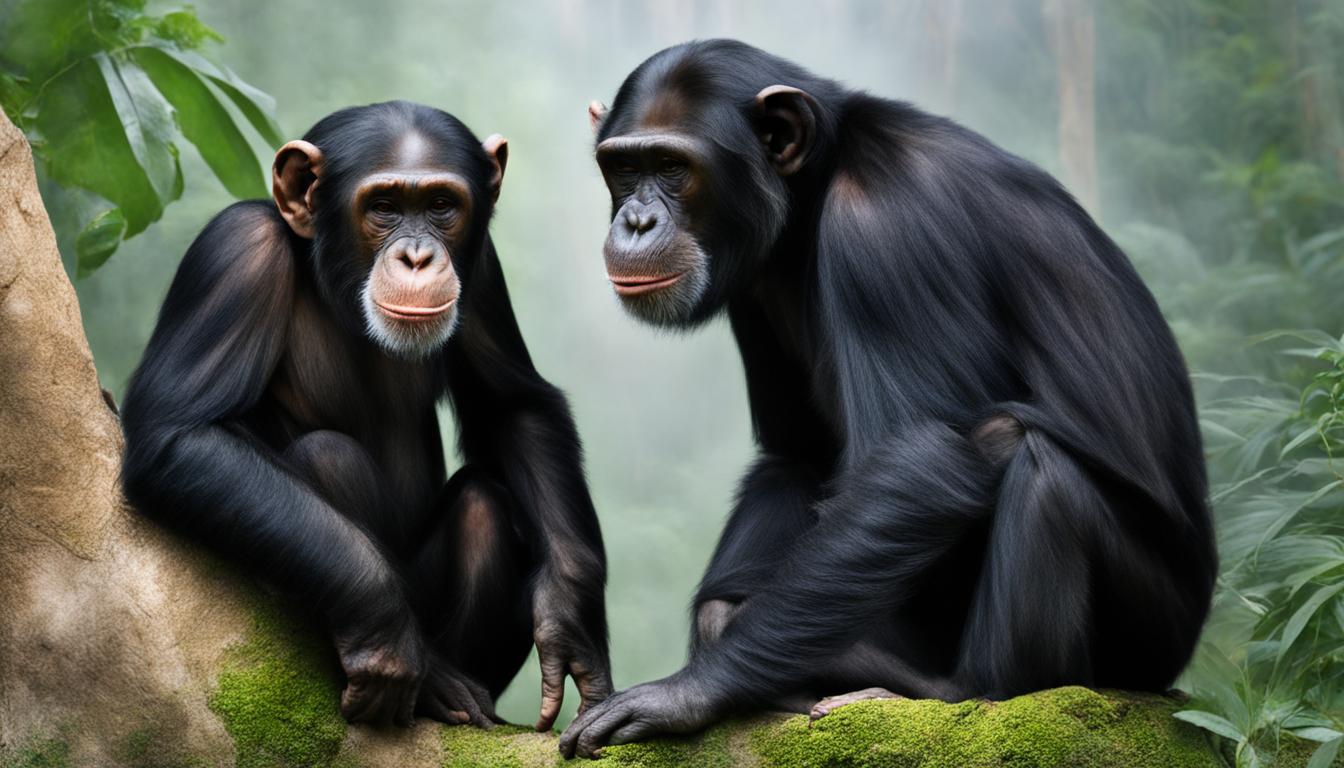Chimpanzees, living in their natural habitats, engage in fascinating social interactions that involve intricate communication methods. These highly intelligent primates possess unique ways to convey information and social cues to one another. Understanding their non-verbal communication in the context of their social behavior provides valuable insights into the complex dynamics of these remarkable creatures.
Non-verbal communication is crucial for chimpanzees to navigate their social world and maintain strong bonds within their communities. By using gestures, facial expressions, and body language, they can effectively convey information, share emotions, and coordinate their actions. Understanding the intricacies of chimpanzee communication provides valuable insights into primate behavior and the evolution of non-verbal communication in humans.
Vocalizations in Chimpanzee Communication
Chimpanzees, like humans, rely on vocalizations as an integral part of their communication system. They produce a diverse range of vocal sounds that hold specific meanings and serve various purposes within their social groups. Chimpanzee vocalizations include alarm calls and social calls, each playing a crucial role in conveying information and coordinating group actions.
Alarm calls are vocalizations that chimpanzees use to warn others about potential threats in their environment. These calls can vary in intensity and duration, depending on the seriousness of the perceived danger. The purpose of alarm calls is to alert other group members and prompt a coordinated response to ensure safety and survival.
Social calls, on the other hand, are vocalizations used for communication within the group. They help maintain social bonds, facilitate cooperation, and coordinate group activities. Social calls can convey information about various social contexts, such as food availability, group movements, or interactions between individuals.
Chimpanzee vocalizations are not solely limited to alarm and social calls. They can also express emotions, establish dominance, or mediate conflicts. Each vocalization has its unique acoustic features and distinct behavioral contexts, allowing chimpanzees to convey rich information and maintain social cohesion.
Communication Methods and Social Dynamics
Chimpanzees rely on various communication methods that play a crucial role in their social dynamics. Their ability to understand and interpret social cues allows them to maintain harmonious relationships within their communities. By utilizing a combination of visual, auditory, and tactile signals, chimpanzees effectively convey information and coordinate their actions.
Chimpanzees demonstrate a high level of intelligence in their communication, which enables them to learn and respond to each other’s signals, gestures, and vocalizations. Through extensive observation, researchers have identified a wide range of communication methods employed by chimpanzees, each serving a unique purpose in their social interactions.
One of the most prominent communication methods used by chimpanzees is body language. They utilize various postures, facial expressions, and movements to convey emotions and intentions. For example, a dominant chimpanzee may display an erect posture and make aggressive gestures to assert its authority, while a submissive individual may cower or avert its gaze to show deference.
“Chimpanzees utilize various postures, facial expressions, and movements to convey emotions and intentions.”
Another essential aspect of chimpanzee communication is vocalizations. They produce a range of vocal sounds, including calls, screams, and hoots, to convey different messages. For instance, an alarm call can alert other community members about the presence of a predator, while different vocalizations are used during social bonding and mating rituals.
Furthermore, chimpanzees employ a wide array of gestures to communicate their needs and intentions. These gestures can involve hand movements, body motions, and facial expressions. By combining specific gestures, chimpanzees can express requests for grooming, share food, or coordinate group activities such as hunting.
Understanding communication methods in chimpanzees provides valuable insights into their social dynamics and intelligence. It highlights their ability to interpret and respond to social cues, fostering cooperation and maintaining social order within their communities.
| Communication Methods | Social Dynamics | Intelligence |
|---|---|---|
| Body Language | Facilitates social interactions, dominance hierarchy, and submission. | Interpreting and responding to non-verbal cues. |
| Vocalizations | Conveying information, alarming others, and social bonding. | Recognizing and producing different vocal sounds. |
| Gestures | Requesting grooming, sharing food, and coordinating activities. | Understanding and using specific gestures for communication. |
Communication and Information Sharing in Chimpanzee Communities
Chimpanzee communities rely on communication to share information and maintain social order. They have complex communication networks that enable them to convey valuable information about resources, potential threats, and social dynamics. By sharing this information, chimpanzees ensure the well-being of their communities and foster cooperation among members.
“Information sharing is crucial for chimpanzees to navigate their environment effectively. They rely on a variety of communication methods, including vocalizations, gestures, and body language, to convey messages to other members of their group.”
Communication networks among chimpanzee communities allow for efficient and widespread information sharing. Through these networks, important messages can quickly spread throughout the group, alerting individuals to changes in the environment, such as the presence of predators or the discovery of food sources.
By exchanging information, chimpanzee communities can make informed decisions and adapt their behavior accordingly. For example, if one member of the group learns about a hidden food source, they can communicate this information to other members, allowing the entire group to benefit from the discovery.
The social relationships within chimpanzee communities play a crucial role in the effectiveness of their communication networks. Strong bonds and trust among group members facilitate the sharing of information and the maintenance of cooperative behaviors.
Table: Examples of Information Shared Among Chimpanzee Communities
| Information Shared | Purpose |
|---|---|
| The presence of predators | Alert group members to potential dangers |
| The location of food sources | Ensure equitable resource distribution |
| Social hierarchy and dominance status | Maintain social order and minimize conflicts |
| Reproductive opportunities | Facilitate mate selection and breeding |
Through information sharing and communication networks, chimpanzee communities collectively gather knowledge that contributes to their survival and success. The ability to transmit information between individuals and generations is essential for maintaining their social structures and ensuring the well-being of the group as a whole.
The Role of Communication in Chimpanzee Cooperation and Hunting
Communication plays a crucial role in facilitating cooperation and successful hunting among chimpanzees. These intelligent primates rely on effective communication methods to coordinate their actions and work together during group activities. By utilizing a combination of gestures, vocalizations, and other non-verbal cues, chimpanzees are able to enhance their chances of obtaining food while maintaining group cohesion.
Cooperation: Chimpanzees exhibit remarkable levels of cooperation when engaging in hunting behaviors. They actively coordinate their efforts through communication, allowing them to strategize and work together as a team. By combining their individual skills and knowledge, they are able to improve their chances of capturing prey.
Hunting: Hunting is a complex and coordinated activity for chimpanzees. It requires the synchronization of actions and the ability to communicate effectively to execute successful strategies. Through communication, chimpanzees can signal their intentions, share information about the location of prey, and collaborate on the most effective hunting techniques.
Chimpanzees utilize a variety of communication methods to facilitate cooperation and hunting. These include:
- Gestures: Chimpanzees use a wide range of gestures to convey information and coordinate their actions during hunting. This includes pointing, reaching, and direction-specific movements that indicate the location of prey or guide group members towards a common goal.
- Vocalizations: Vocalizations play a crucial role in chimpanzee communication during hunting. They can produce various calls and vocal signals to communicate their intentions, coordinate movements, and signal the presence of prey or potential dangers.
- Non-Verbal Cues: In addition to gestures and vocalizations, chimpanzees rely on non-verbal cues such as facial expressions and body postures to communicate during hunting. These cues convey important information about the chimpanzees’ emotional state, intentions, and readiness to engage in cooperative behaviors.
By effectively communicating and coordinating their efforts, chimpanzees can maximize their hunting success and increase their chances of obtaining food. This cooperative behavior not only ensures the survival of individual chimpanzees but also strengthens social bonds within the group.
Understanding the role of communication in chimpanzee cooperation and hunting provides valuable insights into their social behavior and coordination abilities. It highlights the importance of effective communication in promoting successful group activities among these intelligent primates.
The Evolutionary Significance of Chimpanzee Communication
The study of chimpanzee communication provides valuable insights into the evolutionary origins of language and social cognition in humans. Chimpanzees, our closest living relatives, exhibit complex communication abilities and a deep understanding of social dynamics, offering a glimpse into the early stages of language evolution.
By observing how chimpanzees convey information and social cues in their natural habitat, researchers can shed light on the foundations of human communication. Through their use of gestures, facial expressions, vocalizations, and body language, chimpanzees effectively communicate with each other, establishing similarities with our own communication methods.
Furthermore, studying primate communication, including that of chimpanzees, helps us unravel the intricacies of social cognition. Chimpanzees display an impressive level of intelligence in their ability to interpret and respond to social cues, further highlighting the cognitive similarities between humans and our primate relatives.
As we unravel the mysteries of chimpanzee communication, we gain a deeper understanding of our own evolutionary journey. By recognizing the evolutionary origins of language and social cognition, we can better comprehend the complexities that shape human interactions and pave the way for further advancements in the field of primate communication.
Are Chimpanzees’ Conveying Information and Social Cues Linked to Their Communication in the Wild?
In the study of chimpanzee communication in the wild, researchers have found that the conveyance of social cues and information is integral to their interactions. From vocalizations to gestures, chimpanzees utilize a complex communication system to maintain social bonds, coordinate activities, and share vital information within their community.
Do Chimpanzees Use Any Non-verbal Communication Methods to Convey Social Cues?
Chimpanzee communication methods involve various non-verbal cues like facial expressions, body language, and gestures to convey social signals. Through actions like grooming, embracing, or even aggressive displays, chimpanzees effectively relay information without vocalizing. These non-verbal interactions play a crucial role in their social dynamics and relationships.











